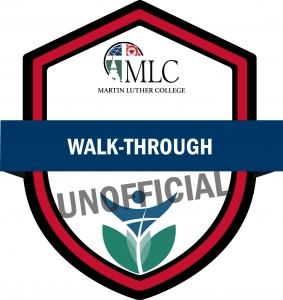MICRO-CREDENTIALS
Formal Recognition for Informal Learning
BDG0116 Walk-Through
DESCRIPTION: Principals or instructional supervisors who earn the Walk-Through Micro-Credential can conduct brief classroom visits that efficiently gather and communicate worthwhile and usable information about student learning.
EARNING THE MICRO-CREDENTIAL: To earn the Walk-Through Micro-Credential, principals or instructional supervisors demonstrate that they have a plan for frequent, quick, ten-minute classroom observation visits; record observation data about student learning; interpret observational data in light of a shared framework of student learning; and reflect useable information back to the teacher. Earners will share a schedule or record of walk-throughs over a period of time and observation notes taken on at least two visits. The earner will also write a reflective paper that describes the school-adopted framework defining student learning, connects the observation notes to that framework, and explains how the observation data was shared with the teacher.
RESEARCH BASE: Walkthroughs that have a clearly communicated purpose with useful feedback positively impact the principal’s ability to influence instruction and student achievement and plan professional development (Boothe, 2013; Rossi, 2007). Teachers report being encouraged by walkthroughs and the accompanying feedback, and they reflect on ways to improve (Brown & Coley, 2011; Rossi, 2007). Such positive impact, however, depends on the quality of the experience (David, 2008).
Boothe, B. D. (2013). Classroom walkthroughs: Impact on student achievement. (Unpublished doctoral dissertation). Baldwin City KS: Baker University. Retrieved from https://www.bakeru.edu/images/pdf/SOE/EdD_Theses/Boothe_Ben.pdf
Brown, G. B. & Coley, K. S. (2011). The effect of walkthrough observations on teacher perspectives in Christian schools. Christian Perspectives in Education. 4(2). 1-24. Retrieved from https://digitalcommons.liberty.edu/cgi/viewcontent.cgi?article=1063&context=cpe
David, J. L. (2005). What research says about . . . / classroom walkthroughs. Educational Leadership. 65(4). 81-82. Retrieved from http://www.ascd.org/publications/educational_leadership/dec07/vol65/num04/Classroom_Walk-Throughs.aspx
Rossi, G. A. (2007). The classroom walkthrough: The perceptions of elementary school principals on its impact on student achievement. (Unpublished doctoral dissertation). Pittsburgh PA: University of Pittsburgh. Retrieved from http://d-scholarship.pitt.edu/8703/
BACKGROUND: The following are useful tools to understand more about the topic.
Moss, C. M. & Brookhart, S. M. (2015). Formative classroom walkthroughs: How principals and teachers collaborate to raise student achievement. Alexandria VA: ASCD. This resource is the best one for a full description of effective walkthroughs.
Kelly, S. (2017). Five keys for more-effective classroom walkthroughs. Harris School Solutions. (Blogpost). Retrieved from https://harrisschoolsolutions.com/blogposts/5-keys-for-more-effective-classroom-walkthroughs/
Video: Pete Hall: Walk-Throughs
MICRO-CREDENTIAL CRITERIA: The walk-through micro-credential earner can do the following:
- Conduct quick, frequent classroom observations.
- Record worthwhile information about student learning within a shared framework.
- Provide prompt, useful feedback that feeds forward.
SKILL DEMONSTRATION:
- Submit a record of classroom visits
The record should include the following:
- Either a plan for—or evidence of—classroom observations over a period of several months.
- The length of each visit (5 to 15 minutes).
- Grade-levels/classrooms for each visit.
- Submit walkthrough observation notes
Keep in mind the following:
- Minimum of two visits for one or multiple teachers.
- Notes provide evidence consistence with supervision framework.
- Submit a Written Reflection
Prepare a written reflection (maximum 400 words) of your walkthrough process that describes:
- The schoolwide (shared by teachers) framework that defines student learning and guides look-fors and feedback.
- How the observation notes connect to the framework.
- How visit feedback is shared with teachers.
RUBRIC:
CLICK HERE for rubric
RESOURCES:
Books
Moss, C. M. & Brookhart, S. M. (2015). Formative classroom walkthroughs: How principals and teachers collaborate to raise student achievement. Alexandria VA: ASCD. http://www.ascd.org/Publications/Books/Overview/Formative-Classroom-Walkthroughs.aspx
Kachur, D., Stout, J., & Edwards, C. (2013). Engaging teachers in classroom walkthroughs. Alexandria VA: ASCD. http://www.ascd.org/Publications/Books/Overview/Engaging-Teachers-in-Classroom-Walkthroughs.aspx
Articles
Protheroe, N. (2009). Using classroom walkthroughs to improve instruction. Principal. 88(4). 30-34. Retrieved from https://www.naesp.org/sites/default/files/resources/2/Principal/2009/M-A_p30.pdf
Cooper, R. (2015). Reimagining classroom walkthroughs. Edutopia (blog). Retrieved from https://www.edutopia.org/blog/reimagining-classroom-walkthroughs-ross-cooper
Kelly, S. (2017). Five keys for more-effective classroom walkthroughs. Harris School Solutions. (Blogpost). Retrieved from https://harrisschoolsolutions.com/blogposts/5-keys-for-more-effective-classroom-walkthroughs/
DeWitt, P. (2016). The myth of walkthroughs: 8 unobserved practices in classrooms. Education Week. (blog) Retrieved from https://blogs.edweek.org/edweek/finding_common_ground/2016/04/the_myth_of_walkthroughs_8_unobserved_practices_in_classrooms.html
Videos
Overview: https://www.youtube.com/watch?v=5Qs75B_4jRs
Overview 2: https://www.youtube.com/watch?v=22C-d2MldT0
Classroom Observation Strategies: Learning Walks: https://youtu.be/pjxg6-fxW2Q
Learning Walks: Structured Observations for Teachers: https://youtu.be/AUTIIOfma90
Martin Luther College Courses
EDU5302 Supervision of Instruction: 3-credit graduate course




